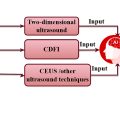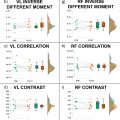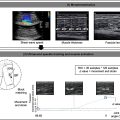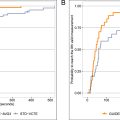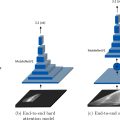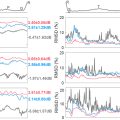Abstract
Objective
Conventional coherent plane wave compounding (CPWC) and sum-of-square power Doppler (PD) estimation lead to low contrast and high noise level in ultrafast PD imaging when the number of plane-wave angle and the ensemble length is limited. The coherence-based PD estimation using temporal-multiply-and-sum (TMAS) of high-lag autocorrelation can effectively suppress the uncorrelated noises but at the cost of signal power due to the blood flow decorrelation.
Methods
In this study, the TMAS PD estimation is incorporated with complementary subset transmit in nonlinear compounding (DMAS-CST) to leverage the signal coherence in both angular and temporal dimensions for improvement of PD image quality. The CST correlation can be performed not only within the same Doppler ensemble (i.e., intra-correlation) but also across the adjacent Doppler ensembles (i.e., inter-correlation) to increase the number of correlation pairs in TMAS PD estimation.
Results
In both simulations and experiments, DMAS-CST is capable of improving the contrast of TMAS PD image by over 10 dB compared to the nonlinear compounding alone by enhanced noise suppression and lower flow decorrelation. When the CST correlations are performed both intra and inter Doppler ensembles, the noise level further reduces in DMAS-CST.
Conclusion
Since the TMAS PD estimation is often limited by the loss of signal power due to temporal decorrelation, the design of complementary subsets in DMAS-CST should be carefully examined to preserve the blood flow signal. Future work of this study will focus on how to combine the conventional PD and the TMAS PD for better signal preservation and effective noise suppression.
Introduction
Plane-wave (PW) imaging utilizes unfocused transmission to illuminate a wide field of view, thereby significantly increasing the frame rate of ultrasound (US) imaging [ ]. After receiving channel echoes from PW transmission, pixel-based beamforming can reconstruct the entire image with a single PW transmission, achieving the frame rate up to kHz. This capability refers to PW imaging as ultrafast US imaging. The conventional beamforming method is delay-and-sum (DAS), which involves time-delay of channel echoes before summation. Ultrafast PW imaging facilitates tracking fast motion and has been widely used to detect the propagation of shear waves in transient elastography [ , ] and blood flow in Doppler detection [ – ]. For Doppler detection, power Doppler (PD) imaging and color Doppler (CD) imaging can be used to acquire power and velocity information of blood flow, respectively. However, due to the lack of transmit focusing, PW imaging suffers from high noise levels and significant side-lobe clutters. To address this problem, coherent plane-wave compounding (CPWC) has been introduced, involving multi-angle PW transmission for synthetic transmit focusing [ ]. Specifically, low-resolution images (LRIs) obtained from several PW transmit angles are compounded into a single high-resolution image (HRI) to improve the image quality of PW imaging. However, the number of PW transmit angles is typically limited to fewer than 10 to maintain sufficiently high frame rates in ultrafast Doppler imaging, which constrains the improvements in CPWC image quality with DAS beamforming.
Novel beamforming methods leveraging signal coherence have been developed to effectively suppress noise and side-lobe clutter in CPWC imaging with limited number of PW transmit angles. Short-lag spatial coherence (SLSC) utilizes normalized correlation between two elements in the signal array with specified lag to suppress the incoherent components in US image [ ]. Similarly, delay-multiply-and-sum (DMAS) calculates spatial cross-correlation among all pairs of received echoes [ ] and has also been elaborated to include flexible emphasis on signal coherence [ , ]. Nonetheless, phase correction should be included in DMAS beamforming to avoid erroneous change of signal phase among consecutive frames which compromises the subsequent Doppler detection [ ]. Another effective method to suppress the noises and side-lobe clutters exploits the correlation between two complementary subsets of the signal array [ ]. Since the noise and side-lobe clutter in one subset is respectively uncorrelated and only partially correlated with its counterpart in the complementary subset, this method achieves substantial reduction in the level of noise and side-lobe clutter [ , ]. Note that the signal coherence includes not only spatial coherence in the direction of receiving channel but also angular coherence in the direction of PW transmit angle. Short-lag angular coherence (SLAC) [ ] and frame multiply and sum (FMAS) [ , ] leverage angular coherence to improve the quality of PD imaging in ultrafast PW imaging. The complementary subset method can also be applied in the angular dimension [ , ] by dividing the PW transmit angles into two subgroups to suppress low-coherence image artifacts. Note that the design of complementary subset in the angular dimension may affect the image resolution when the angular aperture size reduces to half in each subset. Moreover, integrating signal coherence in both spatial and angular dimensions has been reported to provide further improvement in image quality [ , ].
In addition to leveraging signal coherence in spatial and angular dimensions, the quality of ultrafast PD imaging can also be improved by adopting novel Doppler power estimation algorithms to exploit signal coherence in the temporal domain. Conventionally, PD estimation involves incoherent summation of Doppler power for all available ensembles, which reduces noise variance but not noise level. Note that the conventional PD estimation is often understood as the zero-lag autocorrelation ( R (0)) or the sum of square of Doppler ensembles. To reduce the noise level, researchers have proposed using the summation of complex correlation pairs from high-lag autocorrelation between Doppler ensembles to exploit the temporal coherence and reduce the level of uncorrelated noise in PD imaging [ ]. To further suppress the noise level, the authors have proposed to combine the high-lag autocorrelation of Doppler ensembles with the temporal multiply-and-sum (TMAS) algorithm [ ]. The proposed TMAS method is similar to DMAS beamforming but operates in the temporal dimension to highlight the temporal coherence among correlation pairs. Though the TMAS PD estimation can be integrated with multi-angle DMAS compounding to leverage signal coherence in both the temporal and the angular dimensions, the blood flow decorrelation due to velocity gradient would degrade the signal coherence of high-lag autocorrelation and thus lead to loss of Doppler power especially at higher flow velocity. In this study, the modified DMAS compounding with complementary subset transmit (DMAS-CST) is proposed to alleviate the signal decorrelation in TMAS PD estimation. The research methods and the setup of simulations and in vivo experiment are introduced in Method. Specifically, echoes from flowing scatterers in the vessel are acquired for multiple PW transmit angles by using Field II simulation program and the experimental ultrasound research platform. The LRIs are then constructed for evaluation of PD image quality between different compounding methods. In Result, both the simulation and experimental results of TMAS PD estimation with DMAS-CST compounding are demonstrated with comparison to its counterpart without CST. Finally, discussions about the effect of CST design and time interval between the CST subsets on TMAS PD estimation are provided with conclusions.
Methods
Conventional PD estimation
Repetitive pulse transmissions in ultrasound Doppler detection are utilized to track temporal variations of the backscattered signal from blood flow, with a total of N transmissions are implemented for the Doppler detection. The number N is generally referred to as the ensemble length. Each signal recorded from the n -th pulse transmission ( n = 1, 2, . . ., N ) is denoted as the n -th Doppler ensemble. To differentiate the blood flow signal from stationary tissue signals and thermal noise, a clutter filter must be applied to these Doppler ensembles. The clutter filter operates by selectively extracting signal components with frequencies falling between a low-order and a high-order threshold. These extracted components are used to achieve precise velocity estimation in CD or power estimation in PD. The clutter filter may take the form of a simple temporal filter or a more sophisticated spatial-temporal filter, such as singular-value decomposition (SVD) [ , ]. Subsequently, blood flow estimation is conducted using the autocorrelation of these clutter-filtered Doppler ensembles [ , ] as
where the symbol * is for complex conjugate and y(n)?(?)
y ( n )
denotes the n -th baseband Doppler ensemble after clutter filtering, and k represents the correlation lag number. The conventional PD estimation is computed as the R (0):
PDconventional=R(0)=1N∑n=1Ny*(n)y(n)=1N∑n=1N|y(n)|2
Note that the conventional PD estimation in (2) is calculated by the normalized incoherent summation of the squared magnitude of all of the N Doppler ensembles (i.e., sum of square). Therefore, despite employing the larger number of Doppler ensembles in PW imaging, the resultant PD imaging only exhibits a reduction in noise variance rather than a reduction in the noise level.
TMAS PD estimation
Based on the coherence-based approach for PD estimation developed in [ ] which leveraging the signal coherence of higher-lag autocorrelation (i.e., k > 0 in (1)), the TMAS PD estimation [ ] further highlights the signal coherence by multiplying every possible k -th correlation pair before their summation instead of the directly summing the correlations pairs and can be implemented in similar approach to the BB-DMAS beamforming [ ]. Representing the k -lag autocorrelation as s(n)=y*(n)y(n+k)?(?)=?∗(?)?(?+?)
s ( n ) = y * ( n ) y ( n + k )
( n = 1, 2, . . ., N – k ), the k -lag PD with TMAS estimation can be defined as
Here, the pt -th power is applied to the coherent summation of the correlation pairs to include the signal coherence through mutual multiplications. Nonetheless, since the pt -th power operation would alter the unit of Doppler power, the correlation pairs are scaled by pt -th root beforehand to keep the unit of Doppler power unchanged. It should be noted that a higher pt value in the TMAS algorithm is used to highlight more temporal coherence among the Doppler correlations. When pt = 1, the k -lag PD with the TMAS algorithm in (3) will degenerate to the conventional higher-lag power Doppler as in [ ]. This coherence-based PD offers a lower noise level compared to conventional PD due to significant noise reduction in the coherent summation of complex correlation pairs. For instance, a ten-fold increase in the ensemble number results in a 5-dB decrease in the noise level when pt = 1. The noise suppression would further improve with increasing pt value. Take pt = 2 as an example, the number of uncorrelated noisy components increases from N−k
N − k
to (N−k)2
( N − k ) 2
in the coherent summation, yielding a 10-dB decrease in noise level per ten-fold increase in the ensemble number [ ].
cDMAS compounding
Conventionally, the CPWC method is utilized to obtain HRIs as Doppler ensembles for the TMAS PD estimation and thus suffers from low image quality especially when there is no enough PW transmit angles to suppress the off-axis clutters. In this case, novel compounding schemes using angular coherence among LRIs may be combined with the TMAS PD estimation to provide both improved image quality and effective noise suppression. DMAS compounding with phase correction (cDMAS) [ ] alleviates the degradation of temporal coherence among Doppler ensembles and thus is a better candidate for the TMAS PD estimation than the original DMAS compounding. Given the clutter-filtered LRI from the m -th PW transmit angle in the n -th Doppler ensemble as xm(n)
x m ( n )
, the cDMAS compounding is implemented by using square root to scale the magnitude of xm(n)
x m ( n )
before the coherent summation among different PW angles to provide HRI ensemble.
where M is the total number of PW considered in the compounding and
The signal dimensionality of HRI is then recovered by squaring the magnitude of HRI while keeping the phase of HRI unchanged:
Note that, in the original DMAS compounding, the phase of ˆy(n)
y ^ ( n )
is also squared which leads to significant phase distortion to the subsequent TMAS PD estimation. Recall that the TMAS PD estimation in (3) relies on the coherent summation of the autocorrelation pairs and thus is sensitive to the phase changes between Doppler ensembles (i.e., ycDMAS(n)
y c D M A S ( n )
). It is important to note that, due to the low angular coherence of noise component, cDMAS compounding can effectively suppress the magnitude of random noise. Moreover, cDMAS compounding maintains the phase of blood flow signal similar to the conventional CPWC compounding such that the subsequent Doppler detection would not be compromised. In order to obtain the TMAS PD estimation in cDMAS compounding, the ycDMAS(n)
y c D M A S ( n )
would be autocorrelated before substituting into (3). For conventional PD, on the other hand, the ycDMAS(n)
y c D M A S ( n )
would be directly applied into (2).
DMAS-CST compounding
In DMAS-CST compounding, the DMAS compounding is further combined with the complementary subset transmit (CST) technique to boost the image quality and the signal-to-noise ratio in the subsequent TMAS PD estimation. DMAS-CST depends on the correlation between two subsets of PW transmit angles after the magnitude scaling in DMAS compounding. The idea of complementary subset is similar to that in [ – ] but is defined in the dimension of PW transmit angle instead of receiving channel [ ]. Specifically, DMAS compounding is performed using the available PW transmit angles in each transmit subset and the compounding output is denoted as ˆy1
y ^ 1
and ˆy2
y ^ 2
, respectively, for subset 1 and subset 2:
Stay updated, free articles. Join our Telegram channel

Full access? Get Clinical Tree



